Kieran’s Our City, Our Town, 24 March 2022
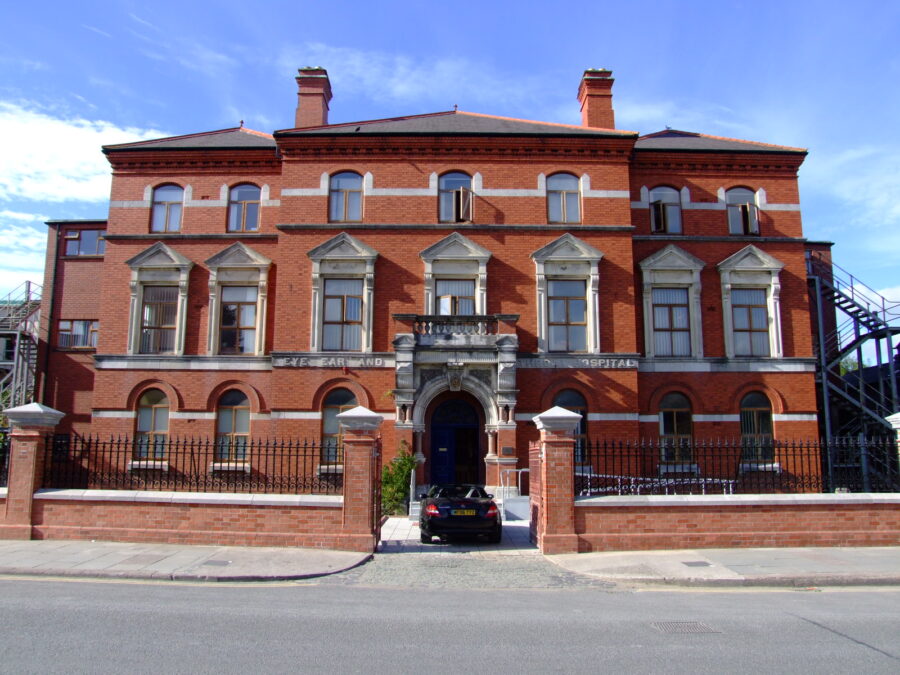
Kieran’s Our City, Our Town Article,
Cork Independent, 24 March 2022
Journeys to a Free State: Eye, Ear and Throat Hospital, 1921-22
Cork’s institutions such as its hospitals offer another lens to look at the life and times of Corkonians amidst the challenges of war during 1921-1922. Cork hospitals usually submitted their annual reports to newspapers such as the Cork Examiner one hundred years ago and their publication provide an insight into their workings and challenges. Indeed, without the annual publication of their AGM reports it is difficult to reconstruct their stories and institutional evolution. Many of the physical paper copies of reports that would have been given to shareholders have been destroyed over the past century.
The annual general meeting of the Cork Eye, Ear and Throat Hospital was held at noon on Saturday 11 March 1922. In 1868 at the age of 24 Henry MacNaughton-Jones founded a 30-bed Cork Eye, Ear and Throat Hospital, in a building at the western end of Sheares Street. He was also physician there between 1868 and 1882. In the first eleven years, the hospital treated over 2,000 intern and 20,000 extern patients. A new hospital building was constructed 200 yards from existing building in 1895-97. Designed by architect James McMullen it has an elaborate ruabon brick with limestone dressings design. The foundation stone was laid by the Mayor of Cork, Patrick Meade on 29 or 30 December 1895. In today’s context the building is still owned by the HSE but its services were distributed to other hospitals in Cork in the late 1980s.
In March 1922, well-known Cork merchant Mr William T Green presided at the AGM with the secretary being C J Lane. The report and statement of accounts for the year 1921 were read. It was noted that it had been a difficult and anxious year in many ways. The hospital had, in common with other fellow institutions suffered from surrounding conditions of war, unrest and instability. Financial questions had caused grave anxiety to the committee, while the insecurity or uncertainty of railway travelling arrangements had caused great inconvenience. Continued high prices of provisions, coal, and other necessaries also rendered more difficult the justification of expenditure.
A total of 2,273 patients received treatment at the extern department involving some 10,000 individual attendances, while 508 were admitted to the wards as intern patients. The report noted that the high number of individual attendances—proved the necessity for such a hospital which had done, so much for patients and especially for children in the city.
For many years extern patients were received and treated gratuitously. In 1920 the committee believed that many of those, who could afford to do so, would gladly contribute voluntarily some small sum towards the working expenses of the extern department, from which they received benefit. Facilities were, therefore, provided for the reception of small voluntary donations, and the committee were content that the “donation box” had contributed during the year the substantial sum of just over £93. The report notes: “The voluntary contributions to the donation box proved that those who came for treatment didn’t wish to be treated as objects of charity. They contributed something towards the upkeep of the hospital, and that showed their independence of spirit, which was a very gratifying feature”.
The revenue from all sources, including subscriptions, donations, and payments from paying patients, amounted to £5,326, while the expenditure was £3.082. The year begun with a debt to the bank of £107 and ended with a credit balance of £137. A donation of £534 from the Welfare of the Blind Fund was received through the Local Government Board. Another donation of £259 was received as a donation from the Prince of Wales Fund.
The annual subscription list has suffered sadly by the removal of several generous subscribers. It was earnestly hoped that others will come forward to fill the vacant places, and to keep up or augment this, the only stable source of hospital revenue.
The Committee were very grateful for legacies of £99 and £50, received through the representatives of the Mr Thomas Bones and Mr Samuel Kingston, respectively. Both these very welcome, contributions have been added to the reserve fund of the hospital. In considering the question of hospital finances, the Committee venture to hope that sooner or later would be possible to re-establish the Hospital Saturday and other annual collections, which for many years provided a steady source of income for all the hospitals without pressing upon any individual.
Warm thanks were given to the surgical staff for their constant and untiring work in the hospital. In particular the committee thanked the Matron, Mrs Crofts, and the nursing staff under her for their loyal services. Ill health and advancing years led Mrs Crofts to retire in 1921. She had been associated with the institution from its earliest days, for forty years and much of its success could be attributed to her capacity and work ethic.
The vacancy caused was being filled by the promotion of Staff Nurse Murphy, who for the previous seven years had been associated with Mrs Crofts in the hospital. She, as the report highlights had “won the approval of all those responsible for its management and proved her ability to fill the position of matron”.
Caption:
1143a. Former Eye, Ear and Throat Hospital, Western Road, Cork, present day (picture: Kieran McCarthy).
Cllr McCarthy Promotes City Council’s Climate Action Programmes
Independent Cllr Kieran McCarthy has welcomed the ongoing progress of Cork City Council’s Climate Adaptation Strategy and has created and posted a new web page on the Council’s climate action work on his website www.kieranmccarthy.ie. The Council’s Climate Action Committee and the Climate Action Team provide governance and management for all climate actions for which Cork City Council is responsible, including the 66 implementation actions from the Climate Change Adaptation Strategy 2019-2024 and actions contained in the Climate Charter. The majority of these actions are being implemented or ongoing.
Cllr McCarthy noted: “I often get regular requests from students and interested locals on what kind of strands and projects Cork City Council is working on in terms of climate action. The existing and developing programmes are helping to increase resilience on the ground and do tie in with National Climate action programmes. There is a lot going on. There is also some really interesting and innovative partnership work going on in an array of diverse areas from energy, food, green schools, biodiversity, lifelong learning, park development, to funding and supporting Tidytowns and exploring and implementing the sustainable development goals”.
Cllr McCarthy continued; “The City Council’s Climate Action Unit has worked recently with the Glucksman and the Planning Department of UCC to deliver a programme that asked school children what they would do if they had ‘Freedom of the City’. The unit is working with the Public Participation Network and Cork Environmental Forum to support local community groups to develop their own climate action plans”.
“In essence, what I describe as a more innovative urban agenda for Cork is emerging through the lenses of climate action programmes. Such thinking is also emerging as frameworks in the new draft City Development plan. My new web page I have created and posted up on kieranmccarthy.ie pulls together an array of over 30 ongoing City Council led projects, which are very positive for Cork society, provide new innovative angles for Cork’s economic development, and showcase the importance of partnership and leadership”, Cllr McCarthy concluded.
Scenes from Cork’s St Patrick’s Day Parade, 17 March 2022
Kieran’s Our City, Our Town, 17 March 2022
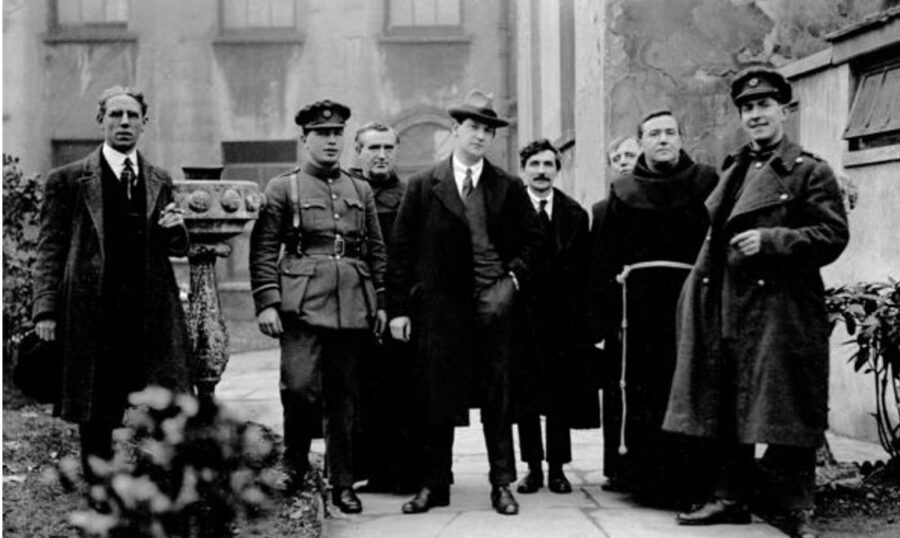
Kieran’s Our City, Our Town Article,
Cork Independent, 17 March 2022
Journeys to a Free State: Deputations and Expectations
The pro Treaty rally hosted by Michael Collins on Cork’s Grand Parade on Sunday 12 March was deemed a success. The following day, Monday 13 March, before taking the afternoon train back to Dublin, Michael took the time with Diarmuid Fawsitt from the Provisional Government’s Ministry of Economics to visit and take a tour of the Ford factory.
The Cork Examiner describes a 9am start. Michael was met with an enthusiastic reception along the route to the factory. Even the quay workers paused to cheer his presence. At the Ford works, the party were received by the factory’s managing Director Edward Grace. He showed Michael the extent of the works including the machinery, the moulding shops and casting shops. In the casting room Michael cast four motor-car cylinders. On the short journey returning to the city centre, Michael was recognised and was acknowledged by labourers working on roads in south docklands.
At Turner’s Hotel on Oliver Plunkett Street Michael Collins received several deputations. The proceedings were in private, but the names of the groups were published in the Cork Examiner. Not only was the lobbying of support for the Treaty, but there was also a job of work to do to resolve economic and social challenges, which faced cities such as Cork. The city had 8,000 people unemployed with a large proportion of whom were artisans, mechanics and unskilled labourers.
A deputation of the Legion of Irish Ex-Servicemen waited on Michael Collins. The position of the ex-service men under the Irish government was gone into, the matters touched upon relating to award granted the dependents of the men killed in the First World War and the question of civil employment.
A deputation on behalf of the Unpurchased Tenants Association urged Michael to complete the land purchase programme and directed attention to the action of certain landlords in threatening bankruptcy proceedings against the tenants. They also urged a temporary reduction pending the completion of land purchase.
Mr George Nason, President of the Cork and District Labour Council, brought matters to the notice of Michael Collins affecting the interests of the trades and the workers generally, with special reference to the unemployment problem.
A deputation on behalf of the Evicted Tenant’s Association was also received in the course of the day by Michael.
John Kelleher (Lyons and Company), John Biggane (Munster Arcade), John Cashman (Cashman & Sons), Michael J Mahony (John Daly & Co), Patrick Crowley (Moore and Co.), William Roche (Roches Stores), and John Rearden, Solicitor, appeared as a deputation about the question of rebuilding the premises destroyed in the Burning of Cork, and to clear up certain remarks regarding the advancing of money for the purpose or rebuilding. Some building owners and architects were ready to start their plans.
The latter remarks were a reference to a meeting of representatives of Cork Corporation and Michael Collins on 22 February 1922. At this meeting Michael noted that the Provisional Government would be in a position to arrange to grant to the extent of finance of £250,000 over a period of time. It was suggested that a sum that a sum of £50,000 would be made available in late Spring 1922 to five or six firms that were ready to pursue contracts. On the 4 March, a Cork Corporation sub committee of nine members was appointed to formulate a scheme for the administration of the available grants and discussion began on the vouching of the claims and the distribution of funding. Diarmuid Fawsitt represented the Provisional Government. By early April 1922, a sum of £10,000 was placed at the disposal of the committee. The money was to be placed to the credit of the City Treasurer.
Michael Collins was interviewed shortly before his departure from Cork on 13 March by the Cork Examiner and asked for his impressions of the Cork meeting. He called the rally a great success, which he deemed the further highlighting of support for the Treaty. He noted “The demonstration was unexpected in its dimensions and enthusiasm. The people came out of their own free will to express their feelings, and then came out without canvassing and without organisation. Of course, I knew that Cork was for us. I knew I was as good an interpreter of the desires of the people of Cork, as anyone, and I am glad my interpretation was confirmed…and everywhere I have gone there has only been approval and assent of the action of the plenipotentiaries”.
Michael continued to speak about how the crowd was not daunted by the gun shots fired at the rally; “The thing that was most marvellous was the coolness displayed by the women – old and young – when a few young men fired shots. I do not blame the men who pulled the triggers. I do blame the people who organised those young irresponsibles, for those people, expected to get a stampede. They know how easy it is to create confusion at a meeting where 50,000 people are assembled, and they got those unfortunate puppets to fire those shots in the full knowledge that if there had been a stampede women and little children would have been trampled under foot. But there was no stampede, everyone stood still, calm, and confident, and the. magnificent altitude of the people prevailed against the intentions of the disruptionists…The will of the people must prevail in spite of these things”.
Caption:
1141a. Michael Collins at St Francis Church, Broad Lane, Cork, on Sunday, 12 March 1922, before the rally at the Grand Parade; (left to right) Diarmuid Fawsitt, economic advisor during the Treaty negotiations; Commandant Cooney, Michael Collins, T.D. Padraig O’Keeffe T.D., Fr Leo Sheehan, Very Rev. Fr Edmund Walsh and General Seán Mac Eoin (picture: Cork City Library).
Kieran’s Question to CE and Motions, Cork City Council Meeting, 14 March 2022
Question to CE:
To ask the CE about the use of Boole House on Batchelor’s Quay and why it remains not in use? The project was undertaken in conjunction and partnership with UCC who co-funded the project with City Council. The property was handed over to UCC who are now in ownership of the building and responsible for its completion. The building remains unfitted out (Cllr Kieran McCarthy).
Motions:
That Silverdale Avenue and Aisleigh Gardens be added to the re-surfacing list for the South East LEA (Cllr Kieran McCarthy).
That the long run of footpath lying adjacent the boundary wall of St Finbarr’s Hospital opposite the Tesco Express on Douglas Road be repaired (Cllr Kieran McCarthy).
That Cork City Council are shocked at the Russian regime aggression and military attack on Ukraine, which goes against all international agreements and norms. The loss of life through this unprovoked attack and act of war is unacceptable. We call on the Irish government and the EU and its allies to take the strongest sanctions possible against the Russian regime. The people of Ukraine are sovereign and our support is with them at this exceptionally difficult time. That this motion be forwarded to Minister Simon Coveney, Minister for Foreign Affairs and Defence (Cllr Kieran McCarthy).
Exploring Tramore Valley Park – Landscapes & Stories, Spring 2022
Kieran’s Our City, Our Town, 10 March 2022
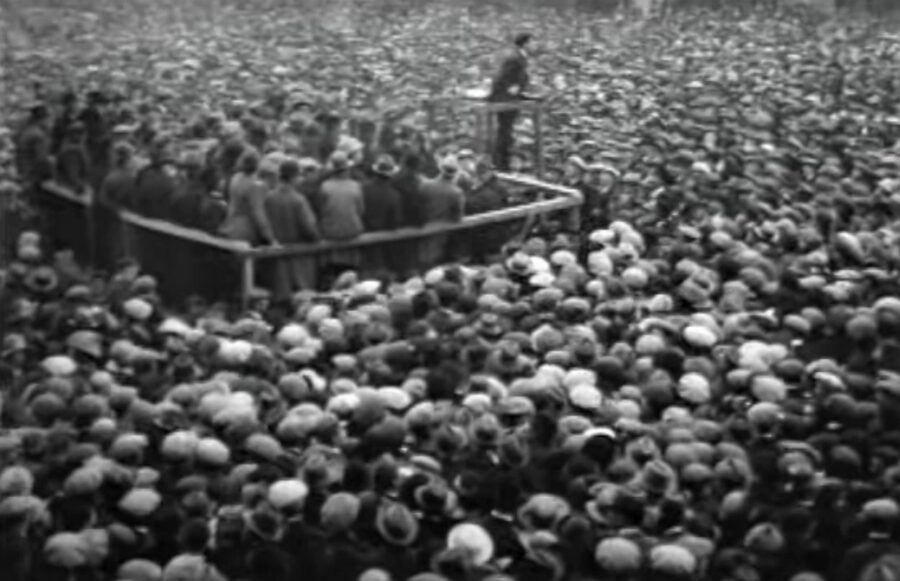
Kieran’s Our City, Our Town Article,
Cork Independent, 10 March 2022
Journeys to a Free State: Collins’ Rallying Call
The first political rally that Michael Collins attended outside Dublin to promote support for the Treaty was in Cork City. All of the regional newspapers of the time including the Cork Examiner had media spreads on the rally. On the second weekend in March 1922, Michael Collins travelled from Dublin to Cork by train, accompanied by Fionán Lynch TD, Commandant Seán MacEoin or MacKeown TD, Seán Milroy TD, and J J Walsh TD.
Michael Collins and Commandant MacKeown briefly addressed the large crowds that had foregathered at some of the railway stations – at Gould’s Cross, Thurles, Limerick Junction and Mallow. Long before the arrival of the train people before to assemble in large numbers in the vicinity of the Cork Terminus, admission to the platform was strictly limited to ticketholders.
On that Saturday afternoon, 11 March, Michael and colleagues were taken through the city in triumph, behind a number of bands. Not everyone was content to see them. A number of armed Republicans halted one band who has set out to meet Collins. They took their instruments at gunpoint and flung them into the River Lee. One band member leapt into the river to retrieve a drum, which was floating down the river. Gunshots were also fired in the air as Collins passed in his car through St Patrick’s Street towards his accommodation at Turner’s Hotel on Oliver Plunkett Street.
During Saturday evening, the two platforms set up on the Grand Parade for the rally the following day were damaged. The wooden planks were hurled into the river. In the area around Turner’s Hotel, Republican slogans were posted as well as several white flags in very visible places. The white flags were a message to Treaty supporters to consider surrendering their stance.
On Sunday morning 12 March, before the rally, Michael Collins and his colleagues, and now joined by other supporters attempted to visit the Republican Plot at St Finbarr’s Cemetery. They were met with twenty armed men telling them if they entered the plot area they would be shot. Meanwhile the special excursion trains from Youghal, Fermoy and Newmarket were raided by armed Republicans. Engine drivers and firemen were kidnapped. The passengers were left abandoned to fend for themselves.
Circa 50,000 people turned up on Cork’s Grand Parade for the rally. Every vantage point was used. At platform no.1, which was nearer to the National Monument Cllr Barry Egan presided as chairperson. The first speaker was Liam De Róiste, who was followed by Michael Collins. The core of Michael’s speech was basically a rebuttal of many of De Valera’s ideas he had presented in previous weeks at his own Anti Treaty rallies across the country. Michael noted: “The Irish people have not disestablished their democratic right to rule themselves. They have claimed that right and fought for it through many generations. They have now at last established that right. They have done more. They have secured recognition of that right by the power which through, all the centuries had denied it. The departure of his forces is the real recognition of that right. It was those forces alone that prevented the Irish people from exercising their right”.
Michael went onto comment on the Treaty negotiations and the success of the British army leaving the south of Ireland. He highlighted; “That interference has come to an end—that interference, the absence of which Mr De Valera lays down as the condition necessary for the existence of a Republic. We took a certain amount of government out of the hands of the economy while he was here. We took as much as we could. But we could not grasp all of it, because he used, the whole of his force to prevent us from doing so, and were unable to beat him out of the country by force of arms. But the enemy is going – will soon be gone, if, indeed Mr DeValera and his friends will but allow them to depart”.
Michael Collins was followed by Seán Hayes, Commandant Seán McKeown TD, Commandant Seán Hayes TD, and Diarmuid Fawsitt. During Seán McKeown’s speech shots were fired during his speech and continued interruptions of shouting was heard all the way to the end of the programme of platform no.1.
At platform no.2, the proceedings had scarcely started when elements of hostility were displayed right in front of the platform. A party of young men, numbering about twenty or thirty, congregated just under the rostrum on which Seán Jennings, Pro Treaty supporter and Chairman of the Cork Board of Guardians, had appeared to open the proceedings. They raised shouts of “Up the Republic”, sang the Soldier’s song, and generally created a din, drowning the voices of the speakers. Within a minute or two, revolver shots were fired into the air. Seán kept speaking but the interruptions drowned him out. At this point Commandant McKeown stood, who had moved over from platform no.1 stood up to take control of the deteriorating situation.
Booming at the crowd, MacKeown declared; “I am not going to be hounded down by four or five men. yes, we sung that when there was danger in singing it. We sang that when we fought for what it meant, and when there was danger in singing it. If Miss MacSwiney called us murderers we fought for the flag, and we are not going to be dictated to by Miss MacSwiney”. Pointing to the group from where the interruptions came, McKeown noted “These men are afraid to hear the truth; they are afraid to let the truth be told even in Cork.
At this juncture a photographer who said he was from an American News Agency appeared on the platform, and endeavoured to take a snap from near where the pressmen were seated. There was immediately an angry rush from the group of interrupters who focussed a revolver at the camera man. The photographer immediately backed down and disappeared from the platform.
Revolver fire became more intense and numbers of people congregated round the platform became alarmed, and there was a slight stampede. The din of the interrupters continued right throughout the meeting and the speakers, Seán Milroy TD, Fionán Lynch TD, J J Walsh TD, Pádraig O’Keeffe TD and Michael Collins TD (who had moved over from platform no.1) were heard with great difficulty.
Over the ensuing six weekends Michael Collins held political rallies from Skibbereen to Waterford, Wexford, Castlebar, Tralee, and Naas.
On the British Pathé YouTube channel there is a film piece entitled “Great Cork Treaty Meeting. Mr Michael Collins receives enthusiastic reception from the huge gathering despite salvoes of shots from a few malcontents”.
Captions:
1141a. Film still from British Pathé of Michael Collins and the crowds on the Grand Parade, Cork, Sunday, 12 March 1922.
1141b. Film still from British Pathé of Michael Collins speaking on the Grand Parade, Cork, Sunday, 12 March 1922.
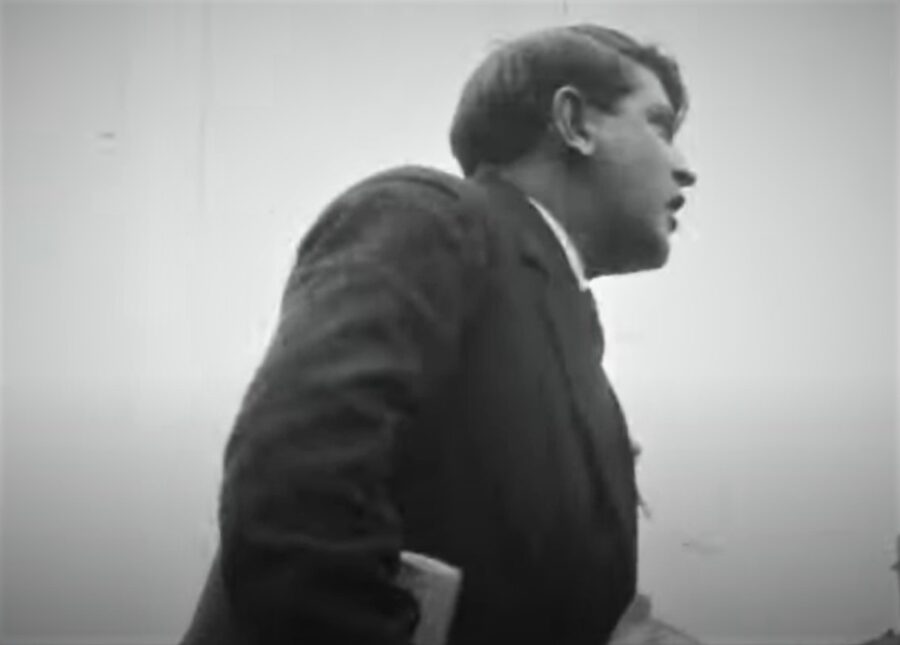
“You and Your Mental Health” Booklet
“You and Your Mental Health” booklet was launched recently. This booklet was produced by Cork Healthy Cities, Mental Health Services and Health Promotion & Improvement.
This booklet is for the adult population and contains really good tips on what you can do to improve and maintain your mental health and wellbeing by building healthy habits daily.
It also introduces the Five Ways to Wellbeing, which are evidence based actions to support our mental health and wellbeing.
https://corkhealthycities.com/wp-content/uploads/2022/02/You-and-Your-Mental-Health.pdf
Kieran’s Our City, Our Town, 3 March 2022
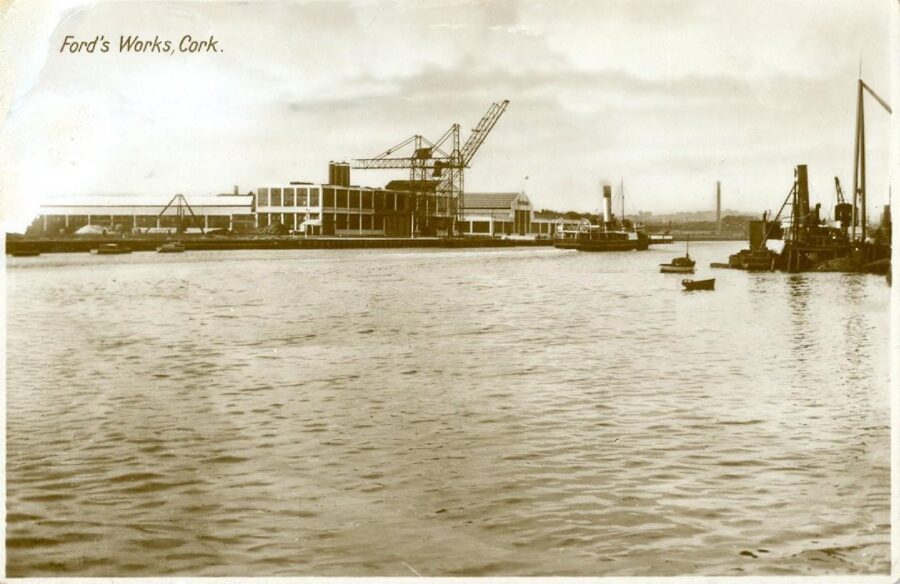
Kieran’s Our City, Our Town Article,
Cork Independent, 3 March 2022
Journeys to a Free State: The Henry Ford Motion
During simmering tensions amongst Treaty and anti-Treaty factions in February and March 1922, a motion passed by eighteen members of Cork Corporation created another stream of tensions amongst Cork citizens. The motion concerned the Ford factory in The Marina and a call to Henry Ford that the target of 2,000 employees as set out in the lease agreement between the Corporation and the company be put in place within two months of the motion.
Henry Ford’s journey to create the tractor factory from first negotiations in 1916 to the first tractor rolling off the production line in mid-July 1919 was not straight forward and ultimately required significant investment on his side. The site of the proposed factory was fully in the possession of Cork Corporation but a racecourse committee held a lease of the land. In 1916, there were 35 years of an agreed lease still in play to the committee at £175 a year. Fortunately, the lease contained a clause that at any time the Corporation could retake possession of the holding, if it was required for factory sites.
The Ford company also required a strip of land on the docks from the Marina to R & H Hall. This was a very valuable site. Henry Ford’s team agreed to pay 7s 6d per foot per annum, which was on par with what R & H Hall and Furlongs were paying to Cork Corporation.
Fords also needed a portion of land that was in the hands of the Cork Harbour Board. It consisted mainly of a wharf that had been erected a few short years before Ford’s arrival. It was built as a docks site to discharge timber and was 500 feet in length. At that point as well in the south docks area, there were also limitations on turning long vessels in the river. Vessels could be no longer than 420 feet long. However, for the four years of the wharf’s existence no vessel of any kind used it. Initially it cost £8000 but the Henry Ford & Son Company paid £10,000 for it to buy it outright.
In addition, to the money that the Henry Ford and Son Company paid down for The Marina site, certain guarantees also had to be signed up to. A total of £200,000 needed to be expended upon the site and buildings and 2,000 men at 1s an hour were to be employed at a minimum – making a total investment in wages alone of over £,4,800 per annum.
For the Ford company, the total spent on the land and buildings ended up close to £275,000. A further £485,000 was spent on equipment and machinery. By early 1920, the company were employing 1,500 men with a weekly wages bill far in excess of anything contemplated at that time at between £8,000 and £9,000 weekly. The rates paid by the company to the Corporation were also substantial.
There were four outside firms in Cork doing sub-production work for the Ford company. One of them was employing 40 men solely on Ford work. In addition, hundreds of men were working indirectly for the Ford company, such as carters, dockers, etc being employed by transport companies in the conveyance of the company’s goods and products. In short, the Ford investment annually into the Cork economy was quite substantial.
Edward Grace, Managing Director of Fords in Cork, wrote to Lord Mayor Donal Óg O’Callaghan and the members of the Corporation re-iterating the company’s significant investment in Cork and asking them to rescind the motion. The letter was published in the Cork Examiner on 2 March 1922. He described that before Ford’s arrival only 10 per cent of the tractor was manufactured in Ireland; in 1922 it was over 90 per cent, principally in Cork and its neighbourhood. In addition, they were manufacturing the complete engine of a Ford car, a part which was bound for the Ford Trafford Park Factory in Manchester. In early 1922, the company suffered from the general economic slump between Britain and Ireland and had to restrict its employment of staff from a high of 1,500 men employed in 1920 to 940 men in February 1922. However, the 1922 workers were on a rate of 2s 1d per hour, which was double the wages stipulated by the Corporation lease agreement.
The Corporation motion also upset hundreds of Ford workers who met en masse outside the factory on The Marina on the evening of 3 March 1922. They all agreed upon a motion to be sent to the Lord Mayor; “That this meeting of Ford workers strongly protest against the ill-advised and ill-judged action of a section of Cork Corporation, and hereby call on the Corporation as a whole to take immediate steps to rectify what may easily become a serious calamity to us, our families, to the City of Cork. A second motion was also put forward and agreed upon to be cabled to Henry Ford; “That Ford workers, Cork, disassociate themselves from action of section of Corporation. Taking steps to have recent mistake rectified. Your position appreciated and endorsed by the workers”.
Henry Ford was livid receiving the Cork Corporation motion and by 6 March 1922 had ordered the shutting down of his Cork factory. The workers presented themselves to the city’s labour exchange. The exchange already had 8,000 people on its books and telegraphed the Dublin Labour Exchange for extra administration support.
By 9 March 1922, Diarmuid Fawsitt of the Ministry of Economics of the Irish Provisional Government visited the Ford factory accompanied by Liam De Róiste, TD and James C Dowdall, President of the Cork Industrial Development Association. As secretary to the Cork IDA, Diarmuid was associated with the coming of the Henry Ford firm to Cork. At the conclusion of their visit, they strongly called for Cork Corporation to rescind the motion.
A day later on the 10 March, members of Cork Corporation met and the motion was rescinded. Another agreed motion at the meeting set out a call for a resolution; “That the city solicitor confer with the legal representatives of Messrs H Ford with a view to an amicable settlement. That a delegation of two members of council be appointed to wait on Mr Henry Ford and explain the matter fully to him on receipt of his reply to cable of the Lord Mayor”. Ultimately the Ford factory immediately resumed its work under its own terms of progress and through several weeks of negotiation the legal binding element of 2,000 workers was waived by Cork Corporation members.
Caption:
1340a. Ford Factory, Cork, c.1930 (picture: Cork City Library).